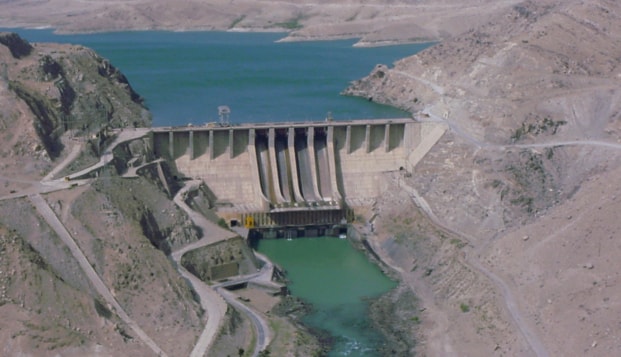
All you need to know about the Salma Dam –The venture sealing the IndoAfghan friendship!
As water gushed out of Salma Dam turbines in Herat after PM Modi jointly inaugurated the biggest and most expensive venture along with Afghanistan President Ashraf Ghani, the lushes marked and sealed the strengthening friendship between the two countries that jointly made this possible.
Ever since the drought of 2002, Pahlawan Piri was doomed with little to no irrigation and the wheat and barley fields lay burnt and scorched. The commonly known as Friendship Dam, is meant to do miracles for the people and farming of the region that it is about to cover.
14 years of waiting for a miracleThe completion of the Dam was an impossible dream for Heartis, something they never thought would be a success because of all the hurdles that kept rearing up. New Delhi’s most difficult foreign hydro power project – the 42 megawatt dam faced the major part of the difficulty with remote locations and not by size which is small according to Indian standards.
Now the city is painted with billboards of which the major part is covered by Modi and the Indian flag, while President Ghani, chief executive Abdullah Abdullah, the water and energy minister Ali Ahmad Osmani share the other half of the credit.
Things to know about the Friendship Dam:1. India’s most expensive project of over $275 million took the hard work of over 1,500 Indian and Afghan engineers and other professionals who committed themselves to making this dream come true. Under extreme conditions, Indian engineers showed commendable dedication and faced the challenges that kept coming along.
2. The Salma Dam owes its completion to WAPCOS, an Indian “mini-ratna I.”
3. The construction included a 107.5 meter high earth and rock-fill dam and a 42 MW power house with three units of 14 MW each.
4. The dam is meant to irrigate 75,0000 hectares of land with reservoir water spreading about 20 k in length and 3.7 km in width; the gross capacity of the dam being 633 million m3.
5. The Salma Dam is 104.3 metre high, 540 metre long and 450 metre wide at the bottom.
6. The completion of the dam took the blood and sweat of many workers, targeted by extremist groups of Taliban.
7. The security provisions by the government of Afghanistan included flying the Indian engineers to the site only once a month.
8. The equipments and materials were transported from India to Bander-e-Abbas port of Iran via sea and then along 1200 km by road to Islam Kila border post at Iran-Afghanistan border and then further 300 km by road from the border post to the site of construction.
9. Neighboring countries of Afghanistan helped by exporting cement, steel reinforcement, explosives and other raw materials.
10. Economic development is expected in the western region of Afghanistan if power and irrigation requirement of the region is met with this project.
Hurdles on the way:1. WAPCOS got the task for the completion of the dam in the year 1957 by an Afghan firm that was given the assignment in the first place. Indian ministry of water resources owned the company. However, the work was soon halted with the Soviet Invasion of Afghanistan in 1979.
2. Soon after the communist regimes of Barak Karmal and Hafizullah Amin took over and Heart city became the centre of Cold War. 20,000 people were killed in the rebellion.
3. Two Indian WAPCOS engineers evacuated along with the armored convoy. One of them went back after 30 years to inspect the Salma Dam.
4. The first WAPCOS delegation went in December 2002 when Taliban was defeated and there were no expecting them to stage a comeback.
5. When Indian engineers reached the construction site in 2006, all they found littering the Hari Rud River was a wind-blown piled up stretch of rusting equipments that was left behind by contractors 25 years ago. There was the leftover destruction of war and explosions everywhere.
6. Connecting the remote site was a dirt road known for its security threats. In 2009 a senior WAPCOS official escaped a close call at being kidnapped on the same road. Ever since, the Afghan Government provided the helicopters that operated once a month.
7. The biggest challenge ever in the construction of the dam was the remoteness of the site. There was no human habitation for at least 50 kilometers where a small mud-brick encampment village stood.
8. The Indian workers brought back all the equipments that were needed, including the seven Volvo tippers that were purchased off Dubai.
9. Basic necessities like Indian cook were soon arranged but a doctor was still hard to get hold of in the region. The first aid kit was the only rescue these workers had in times of medical assistance. No doctor was ready to stay there due to the remoteness of the site.
10. Getting explosives into the site to break the mountains was the biggest challenge ever. The project got stalled for long because of this hurdle until a veteran mujahideen leader, Ismail Khan, stepped in to get the dynamites in the region. He became the biggest ally to help in the completion of the project.
11. Bilateral water dispute with Iran further trolled the project until an understanding was reached between the two nations. There have always been complaints and fingers pointed out at Iran trying to sabotage the India-Afghan venture.
12. Governor of Chisthti Sharif district Abdulqudus Qayam, who was pushing the construction of the dam, was killed along with his five men in January 2010. The Taliban took the responsibility and it was seen as an attempt by Iran who was being blamed for funding Taliban to halt the project.
13. In 2013, the National Directorate of Security (NDS) claimed that the Taliban’s Quetta Shura made attempts to blow up the Salma Dam with 1300 kilograms of explosives.